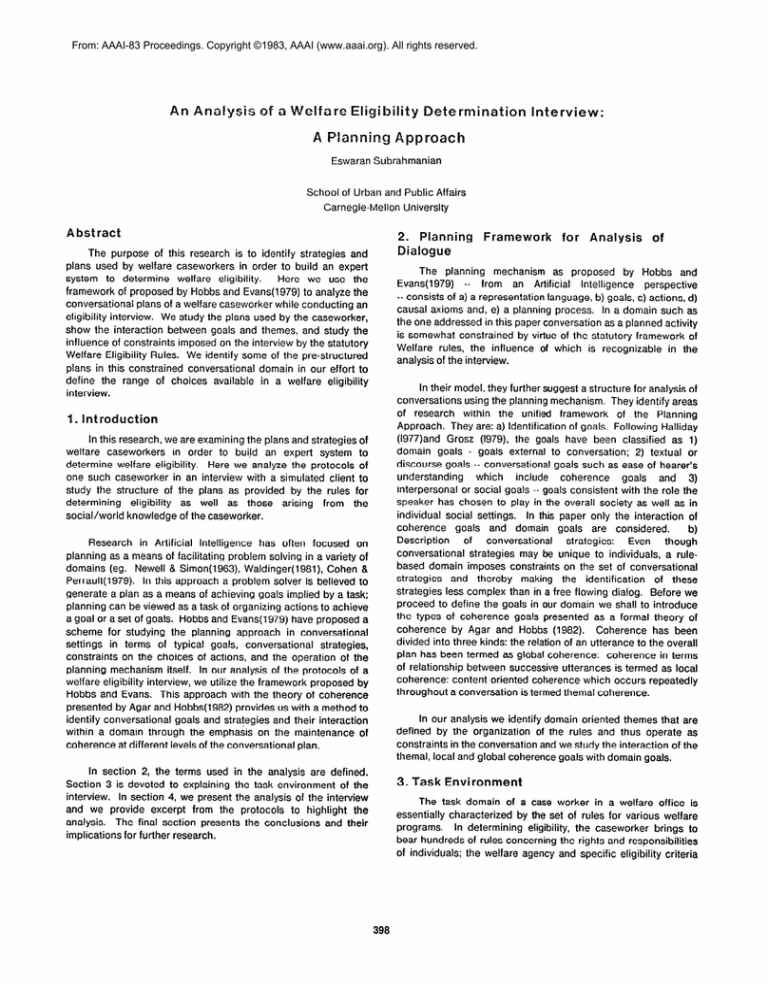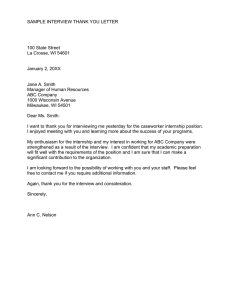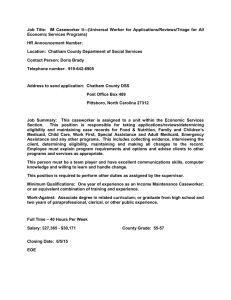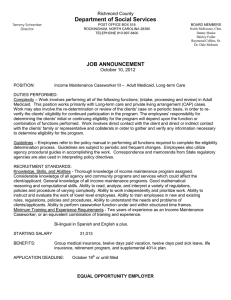
From: AAAI-83 Proceedings. Copyright ©1983, AAAI (www.aaai.org). All rights reserved.
An Analysis
of a Welfare
Eligibility
A Planning
Determination
Interview:
Approach
Eswaran Subrahmanian
School of Urban and Public Affairs
Carnegie-Mellon
Abstract
The purpose of this research is to identify strategies and
plans used by welfare caseworkers in order to build an expert
system to determine welfare eligibility.
Here we use the
framework of proposed by Hobbs and Evans(1979) to analyze the
conversational plans of a welfare caseworker while conducting an
eligibility interview. We study the plans used by the caseworker,
show the interaction between goals and themes, and study the
influence of constraints imposed on the interview by the statutory
Welfare Eligibility Rules. We identify some of the pre-structured
plans in this constrained conversational domain in our effort to
define the range of choices available in a welfare eligibility
interview.
1. Int reduction
In this research, we are examining the plans and strategies of
welfare caseworkers in order to bui,ld an expert system to
determine welfare eligibility. Here we analyze the protocols of
one such caseworker in an interview with a simulated client to
study the structure of the plans as provided by the rules for
determining eligibility as well as those arising from the
social/world knowledge of the caseworker.
Research in Artificial Intelligence has often focused on
planning as a means of facilitating problem solving in a variety of
domains (eg. Newell & Simon(1963), Waldinger(l981), Cohen &
Perrault(1979).
In this approach a problem solver is believed to
generate a plan as a means of achieving goals implied by a task;
planning can be viewed as a task of organizing actions to achieve
a goal or a set of goals. Hobbs and Evans(1979) have proposed a
scheme for studying the planning approach in conversational
settings in terms of typical goals, conversational strategies,
constraints on the choices of actions, and the operation of the
planning mechanism itself. In our analysis of the protocols of a
welfare eligibility interview, we utilize the framework proposed by
Hobbs and Evans. This approach with the theory of coherence
presented by Agar and Hobbs(1982) provides us with a method to
identify conversational goals and strategies and their interaction
within a domain through the emphasis on the maintenance of
coherence at different levels of the conversational plan.
In section 2, the terms used in the analysis are defined.
Section 3 is devoted to explaining the task environment of the
interview. In section 4, we present the analysis of the interview
and we provide excerpt from the protocols to highlight the
analysis. The final section presents the conclusions and their
implications for further research.
University
2. Planning
Dialogue
Framework
for
Analysis
of
The planning mechanism as proposed by Hobbs and
Evans( 1979) -- from an Artificial Intelligence
perspective
-- consists of a) a representation language, b) goals, c) actions, d)
causal axioms and, e) a planning process. In a domain such as
the one addressed in this paper conversation as a planned activity
is somewhat constrained by virtue of the statutory framework of
Welfare rules, the influence of which is recognizable in the
analysis of the interview.
In their model, they further suggest a structure for analysis of
conversations using the planning mechanism. They identify areas
of research within the unified framework of the Planning
Approach. They are: a) Identification of goals. Following Halliday
(1977)and Grosz (1979), the goals have been classified as 1)
domain goals - goals external to conversation; 2) textual or
discourse goals -- conversational goals such as ease of hearer’s
understanding
which
inciude coherence
goals
and 3)
interpersonal or social goals -- goals consistent with the role the
speaker has chosen to play in the overall society as well as in
individual social settings. In this paper only the interaction of
coherence goals and domain goals are considered.
b)
Description
of
conversational
strategies:
Even
though
conversational strategies may be unique to individuals, a rulebased domain imposes constraints on the set of conversational
strategies and thereby making the identification of these
strategies less complex than in a free flowing dialog. Before we
proceed to define the goals in our domain we shall to introduce
the types of coherence goals presented as a formal theory of
coherence by Agar and Hobbs (1982).
Coherence has been
divided into three kinds: the relation of an utterance to the overall
plan has been termed as global coherence: coherence in terms
of relationship between successive utterances is termed as local
coherence: content oriented coherence which occurs repeatedly
throughout a conversation is termed themal coherence.
In our analysis we identify domain oriented themes that are
defined by the organization of the rules and thus operate as
constraints in the conversation and we study the interaction of the
themal, local and global coherence goals with domain goals,
3. Task Environment
The task domain of a case worker in a welfare office is
essentially characterized by the set of rules for various welfare
programs.
In determining eligibility, the caseworker brings to
bear hundreds of rules concerning the rights and responsibilities
of individuals; the welfare agency and specific eligibility criteria
that define categorically needy citizens. The rules provide the
caseworker with the flexibility of integrating his view of the welfare
system, the people who apply for assistance and the objectives of
the agency as specified in the rules for eligibility. To take into
account the possible world views of the caseworker and to
identify the corresponding interpersonal or social goals in the
analysis of the interview is beyond the scope of the paper. Hence
we restrict ourselves to defining domain goals in our task
environment.
from his job as roofer/painter a month ago. The family owns its
own home. The male parent has been doing odd jobs and earned
$200 since he was fired. He was paid in cash for the odd jobs. He
does not receive
unemployment
compensation
or any
employment related compensation. Two of the children go to
school and the mother cares for the youngest child. Previously,
the husband used to work with a roofer in another town. They
have $25 on hand, $200 in the savings account, and $125 in the
checking account. There is no disability in the household.
3.1.
We do not present the entire interview data in this paper due
to space limitations. Rather, we present for analysis extracts of
conversation that are characteristic of the interview.
The
segments chosen for detailed analysis represent two different sets
of domain goals: in segment 1, the caseworker’s goal is to collect
data and to devise plans to verify the data; in segment 2, the
caseworker’s goal is to effect the client’s understanding of the
rules. They also represent two different conversational strategies:
in segment 1, the caseworker questions the client following an
overall prestructured plan based on the rules, but the local
coherence of questioning is dependent. on client’s responses; in
segment 2, the caseworker explains the rules using a
prestructured plan and elaborates at the level local coherence
only parts of the conversational plan that failed in effecting the
client’s understanding.
Domain
Goals and Themes
The domain goals in the overall plan for determining
eligibility can be divided into five high level goals: a) collection of
data pertaining to eligibility; b) verification of the collected data: c)
explanation of rights and responsibilities of the client; d)
calculation of benefits; e) filling out the form. However, the goal
“Calculation of benefits” may be dropped in the case where the
client becomes ineligible while satisfying the other goals. It is
worthwhile to point out that the goals presented here pertain only
to the initial application process that involves the application
interview.
The dominant themes that can be identified from the
organization of the rules are: a) Client Unit data: Data on each
legal member of the Client Unit such as social security number,
residency, names, birth dates, etc..; b) Verification: All data must
be verified to the point of credibility and the client shall be
required to substantiate the information provided; c) Resources:
All resources of the client past, present and future should be
explored as needed. d) Employment: Employment past, present
and future as well as whether exempt from employment due to
condition of the client. e) Rights and responsibility of the client:
concerns the legal rights of the clients in terms of disclosure of
information, rights to appeal and responsibilities of the client to
report changes in the data furnished to the agency. In the next
section our purpose is to see how each of these themes interact
with the domain goals and with the types of coherence goals.
4. Analysis
4.2
Analysis:
Domain Goals
Information
Data
4.3 Analysis:Themal
Coherence
In a rule-based context such as welfare eligibility, we find
determination
collection/
history
applying
*the query
figure
1.
unit*
and
Given that the caseworker has chosen to use the form, she is
not only achieving the goal of filling the form but also providing
herself with a prestructured plan for the domain goals of
“collection of data” and “verification ‘I. In the case of the
“verification” goal the form only provides cues to what pieces of
data have to be verified and to other information relating to
verification, such as date of verification.
The protocols used in the analysis were collected from an
interview conducted by the caseworker on a pseudo client. The
characteristics of the simulated client household are as follows: A
household of five with three children. The male parent was fired
Eligibility
Coherence
The position of different segments in the global interview
plan (Fig. 1) illustrates the global coherence of the segments. In
this interview the global interview plan is similar to the structure of
the application form.
However, there may of course be
caseworkers who prefer not to use the form for structuring the
interview.
of Data
4.1 Background
Global
Segment-2
others
Segment-l
plan in the segments under
Global
Interview
Plan.
these
399
headings
follow
the
Form
that themal organization of the rules and the form play a very
major role in the maintenance of themal coherence in the
“Employment,”
The themes “Personal data,”
interview.
“Resources,” and “Rights and Responsibilities” are dealt with in
The deviations are due to
a compartmentalized
manner.
1.32
1.47
1.48
overlapping of themes as in the employment related resources
where both the themes “Employment” and “Resource” occur
together within the “employment” theme. Verification is the only
theme that occurs over and over again in different parts of the
interview interspersed with other themes. ’ The theme of
“verification” is an implicit theme as the caseworker in order to
achieve the goal of verification, devises plans to acquire known
forms of verification documents available for a given piece of
data. In certain other situations the caseworker also devises
multiple plans to achieve the verification goal. Here, the goal of
verification of all data collected is emphasized to the client by the
caseworker devising plans with the help of the client when
possible. “Verification” is unique in this domain as it appears
both in the form of a goal as well as a theme.
Analysis:
Local
Segment
Coherence
1.1;
1.12
1.13
1.14
CL:no,
1.59
CL:100
CW:
2.
40
1.19
1.20
1.21
1.22
1.23
1.24
1.25
1.26
1.27
1.28
1.29
1.30
1.31
he pay you.
dollars.
dollars.
Caseworker
Transcrint
, CL:
of
Client)
Protocol
z
Seament
L
of the question to follow is generated (1.2).The response (1.3)to
in Interview
We represent the local coherence of questioning in Figure 3.
This strategy is used in several segments of the interview. She
seems to use a prestructured plan to initiate the query under a
particular theme.
The prestructured plan arises in some
background
Introd.
-Topic
of theme
Identification
tFGcTopic
-verification
paint.....
:
1.18
a muffler
the general query directs further conversation. In this case the
caseworker
in (1.4-1.11)
declares that she is using a
prestructured plan for her query. She uses the prestructured
query because
of inferences drawn from her previous
experiences about the cognitive world of the client. In (1.12)she
maintains local coherence by generating queries that are related
to the response of the client in (1.3). She explores the frequency
and the place of work in (1.12-1.18).
She then explores the
amount of work (1.20) wage rate for the work (1.22) and number
of jobs (1.24). She clearly is expanding on the topic of odd jobs
by querying the different attributes that characterize an odd job.
In the fragment(l.24) by querying an attribute of the job, she
moves towards the plan for verifying the data by collecting
information on the employers in each of the odd jobs (1.26-l .47).
In order to collect the data on amount and type of work done, she
sets up a conversational structure (1.48~150)and repeats it for
each of the employers.
'no'.
and
CL:about
did
declared (l.l)and a query representing the general classification
1
jobs.
I fix cars
1.51
work
The segment of conversation (fig. 2) is typical of the
introduction of a new theme in the interview. First the theme is
I have gotten
explicitly
to specifying.
You said you employed doing odd jobs.
How often
do you do odd jobs?
CL:Oh.
maybe
lo...15
hours a week.
CW:a week. Is it the same place you do
these
1.15
say
1.50
taken off.
CW:how much did
Fig.
1.1 CW: There are bunch of questions
are on
employment.
employed part-time
full-time,
Are you
1.2
employed or you do
self
odd jobs.
1.3
1.4 CL: I have odd jobs.
1.5 CW: Odd jobs.
I
go through
deeply
into
The reason
1.6
specifying
the type of
I am concerned
with
employment
is
1.7
I have had clients
because
who on asking
are they employed?
1.8
will
1.49
CL:none
else.
CW:that's
it. what kind of
you do for Mr. Jones.
CL:i fixed his car. he had
note:
In the segments of conversation that are analyzed in the next
subsection we will illustrate how verification operates as both a
goal and a theme.
4.4 Analysis:
Segments
number
for him
I . he lives about
5420 Rosewood
blvd.
CW:who
else did you do jobs for?
CW:Is
it at your home you fix cars or
do you work for a natural
business.
I fix in my house or
CL:no,
I may fix at their house.
CW:how
much work have you had this
month?
Cl:this
month,
about 15 hours.
CW:How much do you take per hour?
CL:1 usually
charge
people
by the job.
CW:by
the job. ok. How many actual
jobs
have you done this month?
CL:ahm
three or four
CW:whom did
you done the
jobs
$4J
‘--,
probl[then
subtopic
subtopic
subtopic
(query)
(wry)
OwW
query
planlt---
query
pl an2f
Solution
4
Categorization
of query
+* Query plan1
and query plan2 are plan
structures
Constructed
so as to repeatedly
use them to collect
data
rega.rdi ng
i terns
under subtopic
3.
figure
3. Structure
of Seament-1.
for?
CL:Christopher
Jones.
CW:his
address?
CL:somewhere
in
Rosewood
blvd.
CW:do you have phone number
for him.
I don’t
have a phone
CL:1 guess.
400
segments from the caseworker’s knowledge of the cognitive
world of the client as in (1.1-l .2) and in other segments plans are
constructed to obtain request information in such a way that the
structure can repeatedly be used to exhaust the collection of
similar data as in (1.43-l 58).
1st
4.4.2.
2.1
2.2
2.3
2.4
Analysis:
Segment
2.10
2.11
2.12
2.13
2.14
2.2;
2.21
2.22
2.23
2.24
2.25
2.3;
2.33
2.34
2.35
Figure
Protocol
:
Seament
explanation
by example
I
outcome
Fioure
L
Structure
of
seament-2,
Conclusions
The paper analyzes an interview conducted in a domain
where the goals of the interview are clearly specified.
The
application form is prestructured to capture the essential data
from the interview and also serves as a summary of the interview
v@en completed. The reason for using the form or not using the
form during the interview depends on the role the caseworker
views himself/herself to be playing in social settings such as the
welfare office and hence cannot be accounted for.
In this paper, we have observed that, in order to maintain
global coherence, the caseworker has adopted a global interview
plan provided by the structure of the form. Of particular interest
in the analysis is the richness in the planning structure of locally
coherent queries in the interview. For example the caseworkers
while maintaining local coherence constructs plans that can be
used repetitively to collect data that are attributes of a particular
object such as the client’s employer.
There is no excuse for not reporting
that
comes out.
CL:You mean any kind of money?
I am concerned
there
is
CW:Yes, as far
an overpayment.
CW:I don’t
care,whether
‘you sold dope on
the streets,
that
is one of the type of
income you have.
of
I then
then
If any of these
is not reported
within
a week it is going to result
in an overpayment
in your assistance
grants,
which means you are
getting
more money than you are
eligible
for.
The
government
is going to want the
money paid back and
it will
prosecute
if there
is
an overpayment.
Prosecution
means is fining
and
imprisonment
Transcrint
Riquest
for query
/
consequence
It is is your responsibility
to
provide
us with
correct
information
and report
all
changes within
a week.
It is extremely
important.
Any question
at this
point.
care if you worked
half
an
I don’t
hour, you have to declare.
Whether
it is under the table.
odd jobs..
6:
2nd topic
then
who is an applicant
CW: Everybody
who goes through
this
interview
must
have this
form explained
to them and
they must sign this
form saying
that
they understand
what their
right
to responsibilities
are.
. . . . the right
to appeal
anything..
..
2.;
topic
2
We are currently analyzing protocols of another caseworker
for the client case presented in this paper. We are evaluating the
protocols for other client cases as well to identify plan structures
across cases. However specific these observations may be to this
domain, we believe that identification of planning structures at
different levels of coherence could contribute towards identifying
different prestructured conversational plans in similar rule based
contexts. The identification of planning structures within such
domains can be used in building expert systems based on the
planning approach.
2
The segment in figure 4 is different from other segments in
that the goal is the explanation of the theme of rights and
responsibilities of the client. We represent the local coherence of
explaining rights and responsibilities of the client in Fig. 5. It is an
explicit theme and is announced and elaborated (2.1-2.4). All the
rights are first explained (2.5-2.9).
The responsibilities of the
client are subsequently explained in general terms (2.9-2.11).
While soliciting for questions (2.12), she proceeds to “expand” on
the types of data that are to be reported (2.13 - 2.19). In the
fragment (2.20-2.22) the “consequence” of not reporting and in
(2.23-2.32) the “outcome” of such a consequence are laid out in
the conversation. The client raises the issue of the means by
which the money is acquired (2.33). The caseworker explains
with an example (2.34 - 2.35).
1. Agar, M. & Hobbs, J. ” Interpreting
Discourse:
Coherence and Analysis of Ethnographic Interviews,”
Discourse Analvsis, 1982(l), 1-32.
2. Hobbs, J. & Evans, D. “Conversation as Planned
Behavior,” Coqnitive Science, 1980 4 (3) 349-377.
3. Grosz, B. “Utterance and Objective: Issues in Natural
Language
Communication,”
In Proc. IJCAI-79.
Tokyo, Japan, August, 1979, pp. 1067-1076.
This segment is a prestructured segment of the interview
whose place in the overall interview structure is determined by the
nature of the theme.
However, the actual structure of this
segment may vary depending on the perception of the client by
the caseworker.
4. Halliday, M. “Structure and Function in Language.”
In T. Givon(ed), Syntax and Semantics, Vol 12,
Academic Press, New York,1977.
[References incomplete due to lack of space]
401




